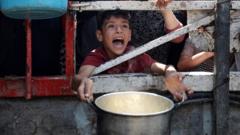Gaza is currently grappling with a severe famine, a situation that continues to worsen despite the presence of aid trucks waiting at its borders. The Integrated Food Security Phase Classification (IPC), which monitors hunger globally with UN support, has reported that half a million individuals—about a quarter of the Gaza Palestinian population—are experiencing conditions described as famine. This disturbing finding highlights that the crisis is "entirely man-made," as aid organizations accuse Israel of 'systematic obstruction' to food supplies entering the territory.
The IPC study reveals that the most extreme starvation, particularly in Gaza City, is leading to distressing conditions of starvation, extreme poverty, and loss of life. Alarmingly, the report indicates that rates of starvation are increasing and predicts that broad areas of Gaza will reach famine levels by September. The IPC's assessment is based on three critical indicators:
1. Extreme food shortage: One in five households faces severe food scarcity.
2. Malnutrition: An estimated one in three children are acutely malnourished.
3. Mortality: At least 20 out of every 10,000 individuals are dying daily, mostly due to malnutrition compounded by disease.
Despite these staggering figures, Israeli Prime Minister Benjamin Netanyahu rebuffs claims of famine in Gaza, attributing hunger to aid organizations and Hamas. He suggests that international aid agencies have not efficiently managed the aid waiting at Gaza's borders. The situation has worsened since the war intensified on October 7, 2023, following a Hamas-led attack on Israel, leading Israel to enforce heavier restrictions on goods entering Gaza, ultimately causing a near-total blockade.
Following international pressure, Israel tentatively permitted limited goods into Gaza in late May but has since replaced the UN-led food distribution system with the Gaza Humanitarian Foundation (GHF), which has four limited food distribution sites within militarized regions. This shift has made accessing basic food for many Palestinians perilous, as they risk death from regular violence while attempting to procure aid at these sites. The United Nations reports nearly 1,000 Palestinians have been killed near GHF sites amidst efforts to access aid, primarily due to Israeli military actions.
While there has been a slight increase in humanitarian aid entering Gaza and a temporary decrease in prices of some goods, the market remains severely strained. Current supplies fall grossly short of the estimated 600 trucks daily needed to meet basic needs, with Israel still imposing significant constraints on aid deliveries.
The Israeli government disputes the IPC's findings, alleging the report was biased towards Hamas and relying on false data. However, the IPC has stood by its assessment, arguing that it adheres to recognized standards. This divergence underscores the fraught political landscape and the complexities entwined with humanitarian efforts in the region.
The continued conflict escalates fears, particularly with Israel's recent military mobilization aimed at Gaza City, a region already suffering from famine conditions. Both UN aid organizations and international leaders have expressed grave concerns about the implications of military actions on civilians, especially vulnerable populations such as malnourished children and the elderly. The urgent need for a comprehensive solution to this humanitarian crisis persists as the situation continues to unfold.




















